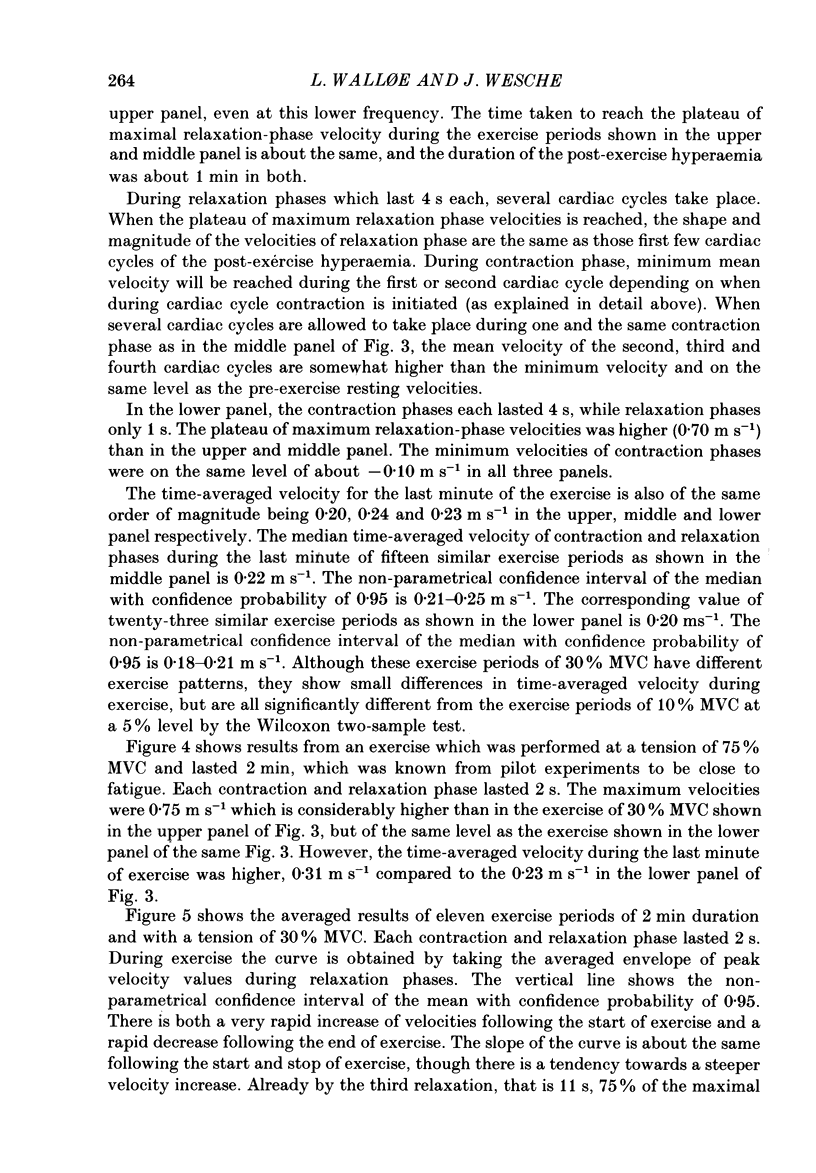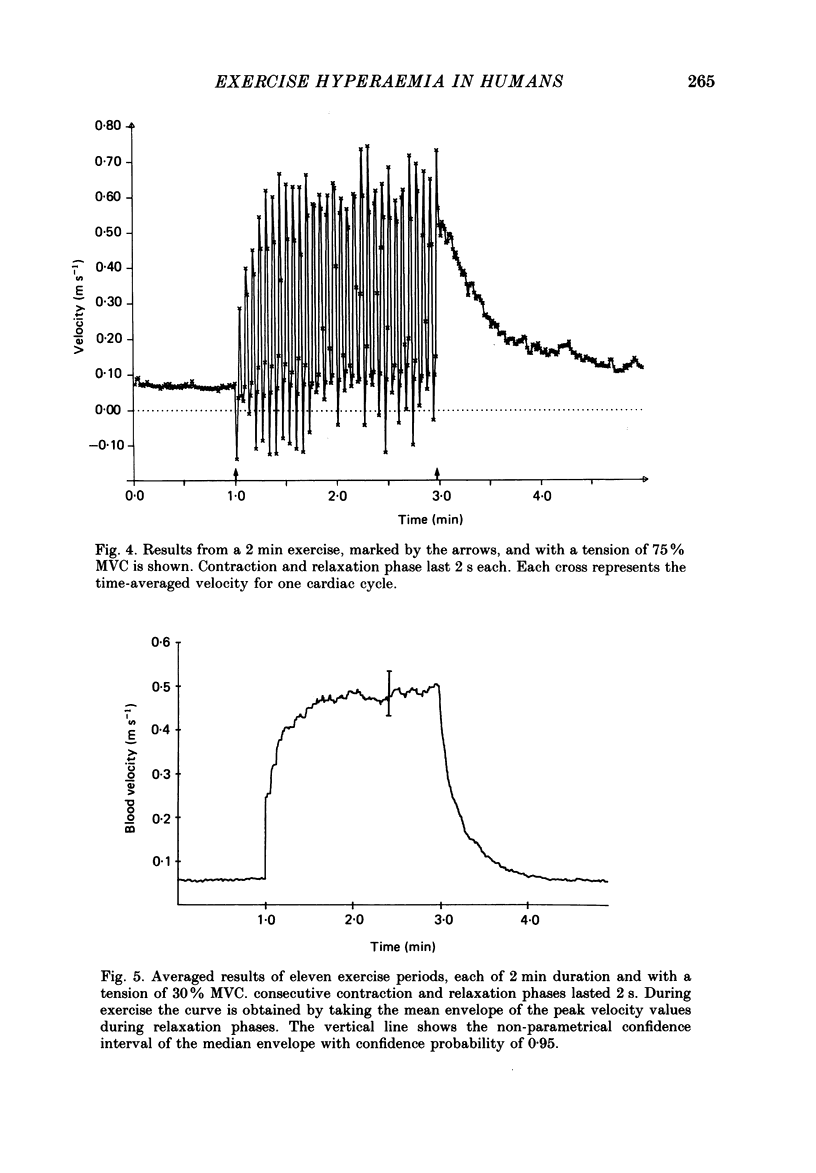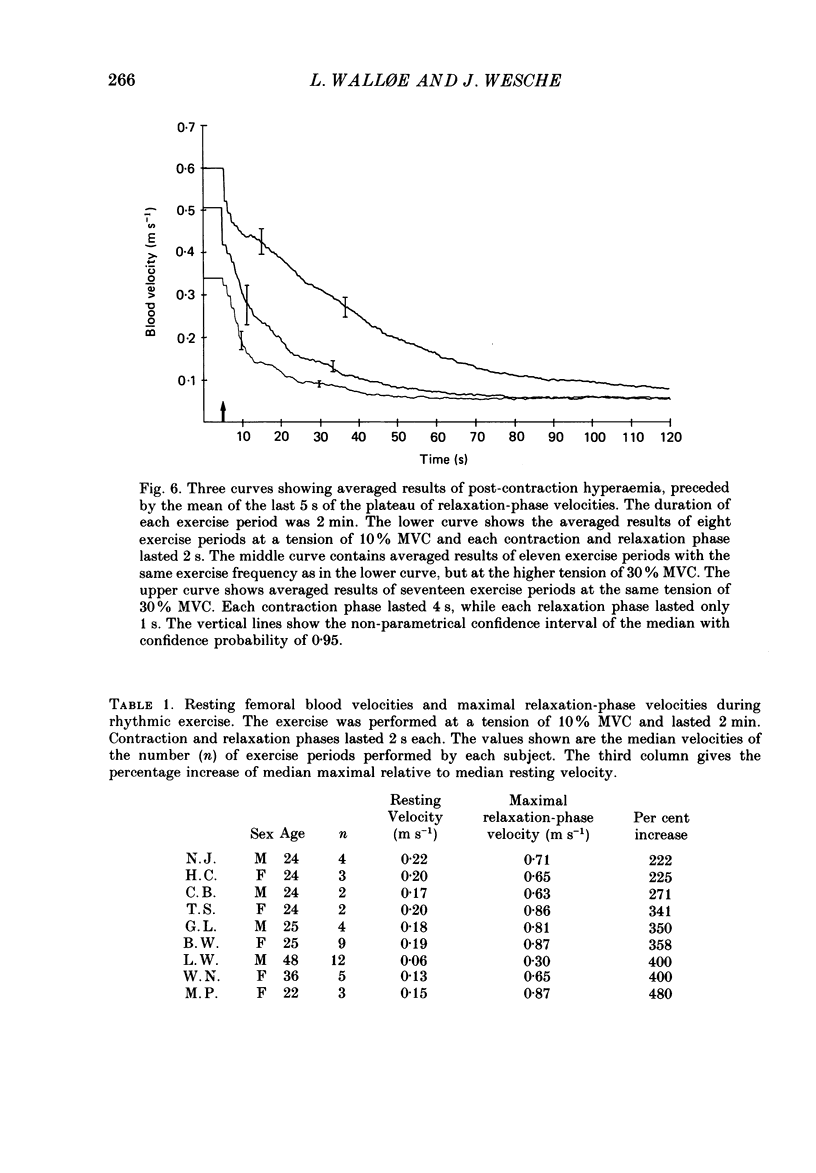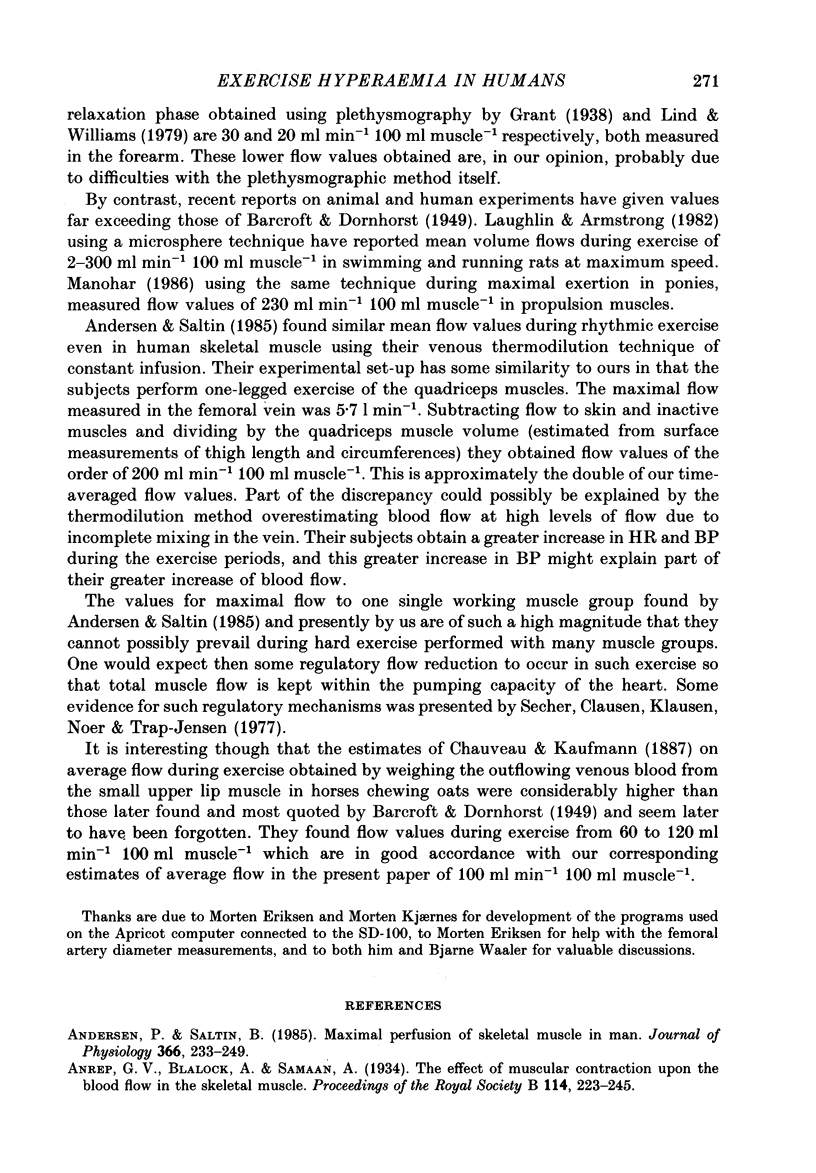Abstract
1. Pulsed bidirectional Doppler-ultrasound equipment was used to measure changes in blood velocities in the femoral artery on a beat to beat basis for consecutive contraction and relaxation phases during voluntary rhythmic exercise of the quadriceps muscle group in man. 2. Rapid and large fluctuations of blood velocities were found, being high during relaxation and low during contraction phases. At the onset of contraction phase, negative velocities were present, indicating retrograde flow. During the rest of the contraction phase, forward flow occurred comparable to the resting flow level even at high loads. 3. Estimated maximal flow to the whole leg during relaxation phase, calculated from these blood velocity measurements and vessel diameter (measured with echo-ultrasound equipment with high resolution) was in two of the subjects 3.32 l min-1 (female) and 5.97 l min-1 (male). When using computer tomography to estimate the volume of the quadriceps muscle group, the calculated maximum flow to this muscle group was 243 (female) and 257 (male) ml min-1 100 ml muscle-1. The time-averaged flow during exercise to the whole leg was 1.51 l min-1 (female) and 2.47 l min-1 (male). The calculated time-averaged flow to the quadriceps muscle group was 101 (female) and 98 (male) ml min-1 100 ml muscle-1. 4. The duration of post-contraction hyperaemia following such rhythmic exercise of up to 6 min duration and up to 75% maximum voluntary contraction was never in excess of 150 s.
Full text
PDF
















Selected References
These references are in PubMed. This may not be the complete list of references from this article.
- Andersen P., Saltin B. Maximal perfusion of skeletal muscle in man. J Physiol. 1985 Sep;366:233–249. doi: 10.1113/jphysiol.1985.sp015794. [DOI] [PMC free article] [PubMed] [Google Scholar]
- Armstrong R. B., Delp M. D., Goljan E. F., Laughlin M. H. Distribution of blood flow in muscles of miniature swine during exercise. J Appl Physiol (1985) 1987 Mar;62(3):1285–1298. doi: 10.1152/jappl.1987.62.3.1285. [DOI] [PubMed] [Google Scholar]
- BARCROFT H., DORNHORST A. C. The blood flow through the human calf during rhythmic exercise. J Physiol. 1949 Sep;109(3-4):402-11, pl. doi: 10.1113/jphysiol.1949.sp004403. [DOI] [PMC free article] [PubMed] [Google Scholar]
- Buchler B., Magder S., Roussos C. Effects of contraction frequency and duty cycle on diaphragmatic blood flow. J Appl Physiol (1985) 1985 Jan;58(1):265–273. doi: 10.1152/jappl.1985.58.1.265. [DOI] [PubMed] [Google Scholar]
- Cronestrand R. Leg blood flow at rest and during exercise after reconstruction for occlusive disease. Scand J Thorac Cardiovasc Surg Suppl. 1970;4:1–24. [PubMed] [Google Scholar]
- Eriksen M. Noninvasive measurement of arterial diameters in humans using ultrasound echoes with prefiltered waveforms. Med Biol Eng Comput. 1987 Mar;25(2):189–194. doi: 10.1007/BF02442849. [DOI] [PubMed] [Google Scholar]
- Folkow B., Gaskell P., Waaler B. A. Blood flow through limb muscles during heavy rhythmic exercise. Acta Physiol Scand. 1970 Sep;80(1):61–72. doi: 10.1111/j.1748-1716.1970.tb04770.x. [DOI] [PubMed] [Google Scholar]
- Gaskell W H. The Changes of the Blood-stream in Muscles through Stimulation of their Nerves. J Anat Physiol. 1877 Apr;11(Pt 3):360–402.3. [PMC free article] [PubMed] [Google Scholar]
- Gault J. H., Ross J., Jr, Mason D. T. Patterns of brachial arterial blood flow in conscious human subjects with and without cardiac dysfunction. Circulation. 1966 Nov;34(5):833–848. doi: 10.1161/01.cir.34.5.833. [DOI] [PubMed] [Google Scholar]
- Guldvog I., Kjaernes M., Thoresen M., Walløe L. Blood flow in arteries determined transcutaneously by an ultrasonic doppler velocitymeter as compared to electromagnetic measurements on the exposed vesels. Acta Physiol Scand. 1980 Jun;109(2):211–216. doi: 10.1111/j.1748-1716.1980.tb06588.x. [DOI] [PubMed] [Google Scholar]
- Hall K. V. Postoperative blood flow measurements in man by the use of implanted electroma-netic probes. Scand J Thorac Cardiovasc Surg. 1969;3(2):135–144. doi: 10.3109/14017436909131789. [DOI] [PubMed] [Google Scholar]
- Hatteland K., Eriksen M. A heterodyne ultrasound blood velocity meter. Med Biol Eng Comput. 1981 Jan;19(1):91–96. doi: 10.1007/BF02443853. [DOI] [PubMed] [Google Scholar]
- Laughlin M. H., Armstrong R. B. Muscular blood flow distribution patterns as a function of running speed in rats. Am J Physiol. 1982 Aug;243(2):H296–H306. doi: 10.1152/ajpheart.1982.243.2.H296. [DOI] [PubMed] [Google Scholar]
- Lind A. R., Williams C. A. The control of blood flow through human forearm muscles following brief isometric contractions. J Physiol. 1979 Mar;288:529–547. [PMC free article] [PubMed] [Google Scholar]
- Manohar M. Blood flow to the respiratory and limb muscles and to abdominal organs during maximal exertion in ponies. J Physiol. 1986 Aug;377:25–35. doi: 10.1113/jphysiol.1986.sp016174. [DOI] [PMC free article] [PubMed] [Google Scholar]
- Pedersen J. E. Fast dedicated microprocessor for real-time frequency analysis of ultrasonic blood-velocity measurements. Med Biol Eng Comput. 1982 Nov;20(6):681–686. doi: 10.1007/BF02442520. [DOI] [PubMed] [Google Scholar]
- Secher N. H., Clausen J. P., Klausen K., Noer I., Trap-Jensen J. Central and regional circulatory effects of adding arm exercise to leg exercise. Acta Physiol Scand. 1977 Jul;100(3):288–297. doi: 10.1111/j.1748-1716.1977.tb05952.x. [DOI] [PubMed] [Google Scholar]
- Thoresen M., Walløe L. Skin blood flow in humans as a function of environmental temperature measured by ultrasound. Acta Physiol Scand. 1980 Jul;109(3):333–341. doi: 10.1111/j.1748-1716.1980.tb06604.x. [DOI] [PubMed] [Google Scholar]
- Wesche J. The time course and magnitude of blood flow changes in the human quadriceps muscles following isometric contraction. J Physiol. 1986 Aug;377:445–462. doi: 10.1113/jphysiol.1986.sp016197. [DOI] [PMC free article] [PubMed] [Google Scholar]
- Wille S. A computer system for on-line decoding of ultrasonic Doppler signals from blood flow measurement. Ultrasonics. 1977 Sep;15(5):226–230. doi: 10.1016/0041-624x(77)90086-5. [DOI] [PubMed] [Google Scholar]


